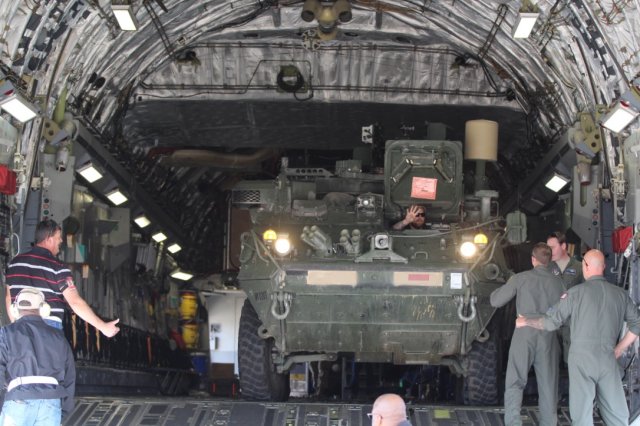 A team of people and vehicles from Fort Sill boarded a plane, Feb. 26, and departed for Germany to test the vehicles’ potential with an active unit. U.S. Army Europe officials requested the two vehicles after seeing their capabilities during stateside experiments against unmanned aircraft systems.
A team of people and vehicles from Fort Sill boarded a plane, Feb. 26, and departed for Germany to test the vehicles’ potential with an active unit. U.S. Army Europe officials requested the two vehicles after seeing their capabilities during stateside experiments against unmanned aircraft systems.
“We know our enemy is using these capabilities,” said Maj. Russell Micho, who works for the Capabilities Development Integration Directorate here. “This threat exists. ISIS is using drones. The enemy is attaching bombs to drones and dropping them on friendly forces and civilians. This threat didn’t exist five years ago.”
In response to the growing threat, developers worked to create a prototype to help detect, identify, and defeat these unmanned aircraft systems (UAS), said Scott McClellan, Fires Support Branch chief at Fort Sill. The result was the development of two counter UAS mobile integrated capabilities, better known as CMIC.
Taking two existing Stryker vehicles (a tactical armored vehicle) McClellan and the Aviation and Missile Research, Development and Engineering Center Science and Technology team took various systems that traditionally have little to do with one another, and created software to integrate them. McClellan quoted Aristotle: “The whole is greater than the sum of its parts,” and explained how the new software enhanced the abilities of each of the individual systems, including those already organic to the original Stryker. McClellan also made changes and upgrades to help specifically combat UAS targets.
“We made some changes such as adding a larger optic,” said McClellan. “The standard size of targets are changing. ‘Tank size’ was the normal size in the past, but now with new technology and with new threats we have to find small objects that are oftentimes impossible to see with the naked eye.”
McClellan called the CMICs a “rapid prototype,” but in truth the two Europe-bound CMIC vehicles took two years to develop. The initial experimentation began in 2014 at Fort Sill’s Maneuver Fires Integrated Experiment (MFIX). During MFIX all the capabilities were spread across a hill and tested individually. Then, during the 2015 MFIX, they combined all the capabilities onto the two Strykers, creating the first CMIC prototypes. In the end, the two CMIC vehicles were used in two exercises at Fort Sill and two more at Fort Bliss, Texas.
Now, as they head to Europe, this will be the first time CMIC vehicles work with an operational unit, said Micho. The CMICs are joining a Stryker unit, making the transition smooth because the Soldiers are already familiar with the Stryker vehicle. However, the CMICs take with them new radios, computers, 3-D mapping, and full-motion video receivers, along with advanced electronic capabilities.
With all the new systems and equipment, Micho said the receiving unit will train for three weeks to understand how to use CMIC. Then two weeks will be spent incorporating them into the unit for them to use as their organic fire-support vehicles for the duration of the loan, which is about 180 days.
“A total of nine people will go with the vehicles,” said Micho. “They will help with equipment training and some will stay for the entire duration of the loan to help with issues as they arise. But the intent is for Soldiers to use the equipment and report back on how to improve on it.”
Photo: One of two counter unmanned aircraft system mobile integration capabilities (CMIC) vehicles is loaded onto an Air Force C-17 jet Feb. 26, 2017, at Lawton-Fort Sill Regional Airport in Oklahoma. The CMIC was headed to Army Europe for testing against unmanned aircraft systems, or drones – Credit: Judy Oman
Source: US Army
